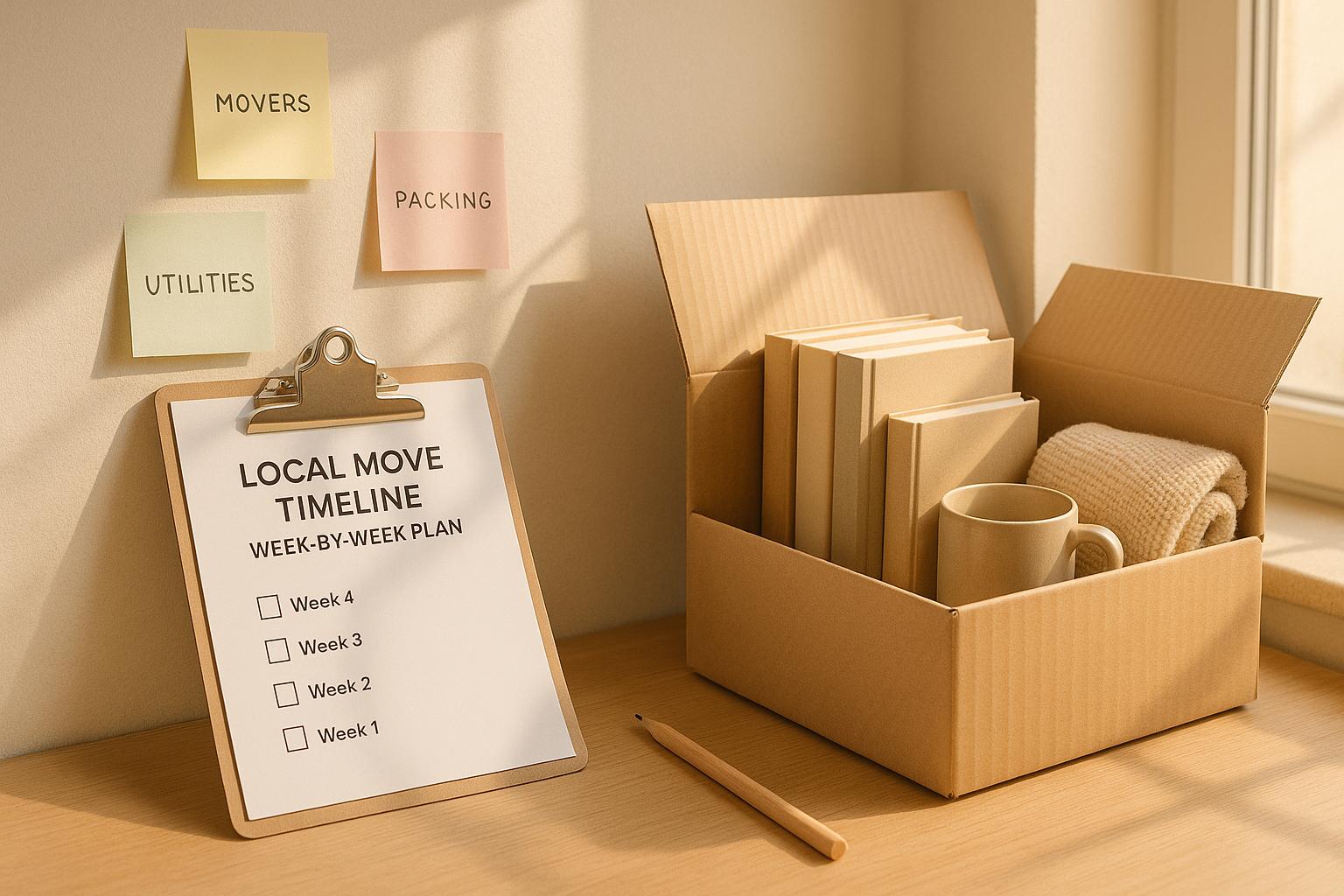Moving house? Start planning 8 weeks ahead to avoid stress and chaos. Here’s what you need to focus on:
- Declutter and sort belongings: Decide what to keep, donate, sell, or discard. Less clutter means lower moving costs.
- Book a removal company: Secure your preferred date early, especially during peak times like summer weekends.
- Gather packing materials: Get boxes, tape, and padding to protect your items. Consider professional packing services for fragile or valuable items.
- Notify utilities and services: Arrange disconnections and transfers for gas, electricity, water, broadband, and council tax.
- Update your address: Inform banks, insurers, the DVLA, HMRC, and healthcare providers to avoid fines or missed mail.
- Organise key documents: Keep contracts, bills, ID, and moving-related paperwork in one place for easy access.
Starting early ensures you stay organised, save money, and reduce last-minute stress. Follow this structured approach to manage every step of your move effectively.
Moving house checklist & timeline | what to do before you move
Sort Through and Declutter Your Belongings
Starting your decluttering process about eight weeks before your move can save you both time and money. Removal companies often charge based on volume, so downsizing your belongings can lead to lower costs. Plus, it spares you the hassle of unpacking items you no longer need or want in your new home. Katie Mortram from Good Housekeeping UK suggests taking a systematic approach to make decisions easier and more effective.
The key is to be realistic about what you actually use versus what you’re holding onto “just in case.” As The Box Co. wisely puts it:
"If you haven’t used it in the last year, you probably won’t use it in the next."
And:
"If you wouldn’t buy it today, don’t take it with you."
Once you’ve embraced this mindset, the next step is to categorise your belongings for a smoother process.
Divide Items into 4 Groups
Using a four-category system – Keep, Donate, Sell, and Discard – is one of the easiest ways to tackle your belongings. Katie Mortram recommends this method because it provides clear boundaries and avoids overwhelming you with decisions.
Begin with areas that tend to accumulate forgotten items, like the loft, garage, wardrobes, kitchen cupboards, or those catch-all drawers and corners. These spaces often contain things you don’t feel strongly about, making it easier to let go. Tackle one room at a time to keep the process manageable.
For each item, ask yourself three straightforward questions: Do I love it? Do I use it? Does it serve a purpose? If the answer to all three is no, it’s probably time to part ways. Laura Price from The Home Organisation shares a helpful rule of thumb:
"If it would take you less than 20 minutes and less than £20 to replace, it’s not worth agonising over."
When it comes to sentimental items, extra thought is needed. Vicky Silverthorn from You Need A Vicky advises:
"What we often do is label something as sentimental, when really, we have just owned it for a long time. So I would encourage people to differentiate between the two."
Keep items with deep emotional significance, but consider photographing others as a way to preserve memories without keeping the physical object.
Also, think practically about your new home’s layout and storage. For example, a large bookshelf might not fit in a smaller space, or bulky sports equipment might not be practical if you’re moving to a flat without a garage. Once you’ve sorted everything, focus on finding responsible ways to donate, sell, or dispose of the items you’re letting go.
Donate or Dispose of Items Properly
After organising your belongings into keep, donate, sell, or discard categories, it’s time to rehome or dispose of the items you no longer need. For donations, consider local charity shops like the British Heart Foundation, which accept items in good condition.
Electronic waste requires special care due to UK regulations. The Waste Electrical and Electronic Equipment (WEEE) Regulations ensure that electronics are recycled properly. These items often contain valuable materials like gold and copper, as well as hazardous substances that should never end up in landfills.
Before discarding smart devices or computers, make sure to perform a factory reset and remove SIM or memory cards to protect your personal data. Batteries and light bulbs should also be removed and recycled through the appropriate channels. Many UK retailers offer free take-back schemes, particularly when you’re purchasing a replacement item. Larger stores (over 400 square metres) are required to accept small electronics under 25cm free of charge.
Your local council’s recycling centre will accept most electronic waste, including small appliances, cables, and batteries. Some councils even collect small electrical items as part of their home recycling services. Check your local authority’s website for specific instructions.
If you plan to sell items, follow professional organiser Carina’s "2-week rule": list the items for sale, and if they don’t sell within two weeks, donate them instead. This keeps the process moving and prevents selling from becoming a bottleneck. Remember, a clutter-free space often outweighs the potential financial gain from selling.
Finally, dispose of hazardous materials like paint, chemicals, and batteries at designated facilities. Your local recycling centre will have specific areas for these items, ensuring they’re handled safely and without harm to the environment.
Book a Removal Service
After you’ve decluttered and streamlined your belongings, the next crucial step is securing a removal service. Aim to book your removal company about eight weeks in advance. This not only ensures you lock in your preferred date but also helps you dodge the last-minute scramble. It’s worth noting that the removal industry has its busiest times, particularly the last Friday of every month. The last Friday in August stands out as the peak day, with four times more people moving than on any other day of the year. Planning ahead also gives you the luxury of comparing different services to find the best fit.
For local moves, booking 4–6 weeks in advance is usually sufficient. However, if you’re looking for better rates and guaranteed dates, eight weeks is ideal. For long-distance moves within the UK, plan for 8–12 weeks’ notice. International relocations require even more time – typically 12–16 weeks ahead.
Pick a Reliable Company
Choosing a removal company isn’t just about finding the lowest price. It’s about balancing cost with the quality of service and ensuring your belongings are handled with care. While affordability matters, the cheapest option may not always provide the reliability or security you need.
Start by checking whether the company is a member of respected trade associations, such as the British Association of Removers (BAR) or the BAR Overseas Group for international moves. Membership in these organisations signifies adherence to strict standards and codes of conduct.
Look for companies with a solid track record. Certifications like ISO 9001, ISO 14001, ISO 45001, and ISO 27001 often reflect a commitment to high standards. Customer reviews on sites like Trustpilot can provide valuable insight into a company’s reliability. And don’t underestimate the power of personal recommendations – friends, family, or colleagues who’ve had positive experiences can be an excellent resource.
Braithwaite’s Removals Ltd, for example, is a family-run business based in Preston, Lancashire, offering a wide range of services. These include house removals, professional packing, furniture dismantling and reassembly, and secure storage solutions with 24-hour CCTV monitoring. Their personalised moving plans cater to both local and UK-wide relocations, ensuring your specific needs are met.
When considering a removal company, prioritise those with an established history and proven reliability. Firms with years of experience often have refined processes and the financial stability to fulfil their commitments. Additionally, verify that the company holds the necessary insurance, such as Goods in Transit and Public Liability insurance, to protect your belongings during the move.
Obtain and Compare Detailed, Written Quotes
Once you’ve narrowed down your options to a few trusted companies, request detailed quotes to make your final decision. Always insist on a free visual or video survey before accepting any written estimate.
"Only consider removals companies if they are prepared to perform a visual survey prior to a written quotation – it is impossible for them to estimate and plan a removal without seeing it first-hand."
This step allows the company to assess your belongings, access points, and any specific needs, helping to avoid unexpected charges. Skipping this survey can lead to surprises – around 6% of reviews mention unexpected fees, averaging £324 in cases where a survey wasn’t conducted.
Request written quotes from at least two to six reputable companies and compare them carefully. Ensure the quotes are based on similar volumes and services. Pay attention to any additional costs, such as:
- Packing services: typically £300–£350
- Furniture dismantling and reassembly: around £100–£150 for two to three items
- Storage options: approximately £93 per month for up to 50 square feet
Clarify the insurance coverage included in the quote. Standard moving insurance often covers up to £10,000 for a single item and £50,000 for total loss. Make sure you understand whether this is through Goods in Transit insurance (provided by an independent insurer) or standard liability insurance, as the claims processes differ.
Check payment terms and ask about potential hidden fees. Many BAR members, for instance, require full payment a week before the move. Confirm that the quoted price is final and inquire about additional charges for delays, storage, or late completion.
Timing can also affect your costs. Wednesdays are considered the second cheapest day to move, while Sundays tend to be the least popular, offering more availability. Avoid peak times like spring, summer, school holidays, and month-end dates to increase your chances of securing better rates and availability.
Whenever possible, opt for a fixed-price contract to avoid price changes on moving day. Read the contract thoroughly, especially terms related to delays, damage claims, and cancellations. Proper preparation will ensure you have a reliable removal service in place, giving you one less thing to worry about as you gear up for moving day.
Collect Packing Materials
Once you’ve booked your removal service, the next step is to gather packing materials that will keep your belongings safe during the move. Start collecting these supplies about eight weeks before your moving date. This gives you enough time to source good-quality materials without scrambling at the last minute, which could lead to overspending or settling for subpar items. Take stock of your home’s needs to figure out the right mix of boxes and packing supplies.
For example, a one-bedroom flat typically requires 20–30 boxes, while larger homes will need considerably more. The exact number depends on the size of your property and how much you own.
Get Boxes and Packing Supplies
Begin by assessing what you’ll need. Walk through each room and group your belongings – books, kitchenware, clothes, and fragile items all need different packing solutions. This mini-inventory will help you decide on the right types and sizes of boxes, as well as any extras like bubble wrap or tape.
Choose a variety of box sizes to suit different items. Here’s a quick guide to typical box requirements based on home size:
| Home Size | Small Boxes | Medium Boxes | Large Boxes | Average Total Cost |
|---|---|---|---|---|
| 1-bedroom | 10 | 5 | 3 | £55 |
| 2–3 bedroom | 10 | 10 | 5 | £70 |
| 3–4 bedroom | 15 | 10 | 10 | £90 |
- Small boxes: Ideal for heavy items like books and tools.
- Medium boxes: Great for clothes, kitchenware, and general household items.
- Large boxes: Perfect for lightweight, bulky items such as bedding and pillows.
For specialised items, consider investing in wardrobe boxes for hanging clothes, dish packs for fragile kitchenware, or mirror boxes for artwork.
You’ll also need other essentials. As a rule of thumb, plan for at least two 166-metre rolls of packing tape for every 15 boxes. For bubble wrap, an average home move requires about 5 metres, but fragile items may need up to 10 metres.
If you’re ordering supplies online, double-check the seller’s credibility and product descriptions carefully. Misleading listings are common – one buyer shared their experience of ordering 100 metres of bubble wrap for £10, only to receive a 50-metre roll instead.
Creative Padding Alternatives
If you’re looking to save on packing materials, think outside the box. Supermarkets often throw away bubble wrap used to protect soft fruits – ask if you can take it off their hands. Old sheets, towels, and even your own bedding can double as padding. These alternatives not only save money but also reduce waste.
For those who prefer reliable, high-quality materials, specialist suppliers like Macfarlane Packaging and UK Packaging are solid options. Be aware, though, that they might have higher prices or minimum order requirements that aren’t ideal for smaller moves. Many suppliers also offer pre-packed moving kits tailored to different house sizes, which can be more economical than buying items separately.
To avoid last-minute stress, order your supplies 2–4 weeks before your move. Flat-packed boxes are easy to store while you wait to use them. Once everything is ready, you’ll be well-prepared to start packing – or you can consider bringing in professional help for certain items.
Think About Professional Packing Services
After gathering your materials, you’ll need to decide if professional packing services are worth considering. These services are especially useful for fragile or valuable items. At Braithwaite’s Removals Ltd, for instance, our team uses top-quality materials and proven techniques to ensure everything is packed securely. This option is particularly helpful if you’re short on time, have physical limitations, or own items that require extra care.
You don’t have to go all-in, though. A hybrid approach works well – pack everyday items yourself and let professionals handle delicate or high-value belongings. Many removal companies, including Braithwaite’s Removals Ltd, offer partial packing services so you can choose specific rooms or categories of items to be professionally packed. Discuss this option while getting your removal quote to ensure availability for your preferred moving date. The earlier you decide, the better your chances of securing the service.
sbb-itb-40214c8
Tell People and Companies About Your Move
Once you’ve sorted your removal service and packing supplies, the next step is to inform key contacts about your move. This ensures a smooth transition with uninterrupted services and accurate billing. Aim to notify all essential parties – such as utility providers, banks, government agencies, and your landlord – at least eight weeks before your moving date. To stay organised, create a checklist of everyone who needs your updated address.
Contact Utilities and Service Providers
Reach out to your gas, electricity, water, broadband, TV, and phone providers at least a week before moving. Arrange final meter readings, account transfers, and disconnections. On the actual moving day, take readings yourself and share them with your supplier, along with a forwarding address for your final bill.
When you arrive at your new home, provide your supplier with the move-in meter readings. If your new property uses a prepayment meter, contact the supplier immediately to settle any outstanding balances and request a new key or card.
For water services, inform your current provider of your move-out date and supply the final meter reading. Then, set up an account with the water supplier at your new address using your move-in readings.
Broadband and internet providers usually require 30 days’ notice for cancellation or transfer, so plan accordingly. This could also be a good time to explore better broadband deals. Notify your broadband, TV, and phone providers at least 30 days in advance to avoid service disruptions.
For council tax, let your current local council know your move-out date to close your account and settle any outstanding bills or refunds. Then, register with the local council serving your new address.
Update Banks and Government Agencies
Notify your banks, insurers, pension provider, and government agencies about your move around a month before your moving date. Most banks and financial institutions allow you to update your address online, which reduces the chance of errors. Don’t forget to inform your insurance providers, as your address can affect your premiums.
For government agencies, update your address with HMRC after you’ve moved. You can do this online via your personal tax account, the official HMRC app, or through their webchat service. Keeping your HMRC details up to date helps prevent financial issues.
You’ll also need to update your driving licence and vehicle registration details with the DVLA. Failing to do so could result in a fine of up to £1,000. Additionally, re-register on the electoral roll through the GOV.UK voter registration page.
If you receive Universal Credit or other benefits, report your new address promptly via your online account or by calling the Universal Credit helpline on 0800 328 5644. This ensures there are no delays in your payments.
For healthcare, inform your GP and other healthcare providers about your new address. If necessary, register with a new GP through the NHS website. To avoid missing any important mail during the transition, consider setting up mail redirection with Royal Mail.
Give Notice to Your Landlord (If Renting)
If you’re renting, it’s crucial to give proper notice to your landlord in line with your tenancy agreement. For fixed-term tenancies, you’re generally required to pay rent until the end of the term unless there’s a break clause or your landlord agrees to an early termination. For periodic tenancies, standard practice is to give four weeks’ notice if you pay rent weekly, or one month if you pay monthly – double-check your agreement for the specific notice period.
Provide written notice to your landlord as outlined in your tenancy agreement and keep a copy for your records. Request written confirmation from your landlord to avoid any misunderstandings. This documentation can be helpful if there are disputes over rent payments or the return of your deposit.
If you need to leave during a fixed term without a break clause, try negotiating an early exit with your landlord. Make sure any agreements are in writing to avoid unexpected fees or obligations. After that, focus on organising your important moving documents.
Gather and File Important Documents
When preparing for a move, having your paperwork in order is just as important as packing boxes or booking a removal service. Start organising your documents early – ideally about eight weeks before moving – to avoid the stress of searching for crucial paperwork at the last minute. Solicitors, estate agents, or removal companies could request these documents at any time, so staying ahead is key.
Set Up a Moving File
Create a dedicated system to keep all your moving-related documents in one secure place. A separate moving file – whether a physical folder or a digital one – ensures everything is easily accessible when you need it. Keep this file with you throughout the moving process to avoid misplacing important papers.
To make things easier, divide your documents into clear categories. This way, you can quickly find what you need. Here’s a breakdown of the key categories and examples of what to include:
| Document Category | Essential Items to Collect |
|---|---|
| Legal & Property | Purchase contract, mortgage offer, building warranties, completion paperwork, inventory (rentals), Energy Performance Certificate, Gas Safety Check |
| Financial | Bank statements, credit card statements, pension documents, quotes from removal services, moving expense receipts |
| Personal Records | Passport, driving licence, birth certificates, medical records, school transcripts, veterinary records, proof of residence |
| Utilities & Services | Utility bills, confirmation emails for transfers, broadband contracts, insurance policies, subscription details |
It’s a good idea to maintain both physical and digital copies of these documents. Scan your paperwork and save it to a secure cloud folder or a password-protected device. This way, even if something gets lost or damaged, you’ll have a backup.
On moving day, take photos of your meter readings – both at your current property and the new one. These photos serve as evidence for your final gas, electricity, and water usage. If you’re renting, go a step further by photographing each room in your old property before leaving and documenting the condition of your new rental when you arrive.
Keep Key Contact Numbers Handy
Once your documents are sorted, compile a list of essential contacts. Save these numbers on your phone and keep a printed copy in your moving file for easy access.
Your contact list should include:
- Your removal company’s direct line
- Your estate agent’s mobile number
- Your solicitor’s office
- Utility providers for both your old and new properties
- Broadband company
- Local council offices
- Tradespeople scheduled for work at either property
Don’t forget practical contacts like your GP, dentist, children’s schools, and your employer’s HR department. If you have pets, include the pet microchip database. Other helpful numbers might include your local council (for parking permits) and a locksmith in case of key troubles.
For added convenience, jot down any relevant reference numbers – such as customer account details, insurance policy numbers, or removal service booking references – next to each contact. This can save time when making calls.
Finally, store this contact list in multiple locations. Save it on your phone, email yourself a copy, and keep a printed version in your moving file. Having this information at your fingertips can make the moving process far less stressful and help you handle any unexpected issues quickly.
Conclusion
Following this 8-week checklist simplifies every part of your move, helping you avoid last-minute panics. Starting preparations two months ahead not only reduces stress but also gives you the chance to tackle each task at a steady pace, saving both time and money.
Planning early has clear benefits. Booking removal services well in advance means you’re more likely to secure your preferred dates and better rates. You’ll also have the flexibility to gather packing materials gradually, steering clear of those inflated costs that come with last-minute purchases. Most importantly, this approach allows you to handle each step thoughtfully, without the pressure of rushed decisions.
By sticking to this structured plan – from decluttering your home to notifying important contacts – you create a solid framework for your move. Completing each task builds momentum, making the entire process feel more manageable and less overwhelming. What might have felt chaotic becomes an organised series of steps, paving the way for a smoother move.
For extra reassurance, professional removal services can take care of the heavy lifting, freeing you up to focus on other important details and easing the load during what can be a demanding time.
FAQs
Why is it important to start preparing for your move 8 weeks in advance?
Starting your moving preparations about 8 weeks in advance gives you ample time to stay on top of things and keep stress levels in check. It’s the perfect opportunity to handle tasks like decluttering, packing items you don’t immediately need, and organising essential services at a steady, manageable pace.
Getting a head start also increases your chances of booking a dependable removal service on a date that suits you – possibly at a better price too. You’ll have enough time to stock up on packing materials, inform the necessary people or organisations about your move, and deal with any surprises that might pop up along the way. Early planning helps make the whole process far more manageable.
What’s the best way to pack fragile and valuable items safely for a house move?
When moving fragile or cherished items, it’s crucial to handle them with care. Begin by wrapping each piece individually using bubble wrap or packing paper to cushion delicate areas. Opt for strong, durable boxes and fill any empty spaces with padding materials like foam or crumpled packing paper to keep everything snug and prevent movement. For particularly delicate items, double-boxing can offer an extra layer of protection.
Make sure to clearly label boxes containing fragile items with ‘FRAGILE’ and use arrows to indicate the correct upright position. If possible, transport highly valuable or sentimental belongings yourself rather than relying on the removal van. These steps can go a long way in reducing the chances of damage during your move.
What should I do if unexpected fees or issues arise with the removal company on moving day?
If unexpected fees or problems arise with the removal company on moving day, try to remain calm and address the issue directly. Start by contacting the company to clarify any charges or misunderstandings. Having your documentation, such as contracts or quotes, readily available can make it easier to support your case.
If the issue can’t be resolved on the spot, you might need to negotiate a temporary solution or pay the disputed fees under protest while seeking further guidance. For more serious disputes, consider submitting a formal complaint to the company. If that doesn’t work, you can escalate the matter to a consumer rights organisation like Citizens Advice. Clear communication and keeping thorough records are key to safeguarding your position.





